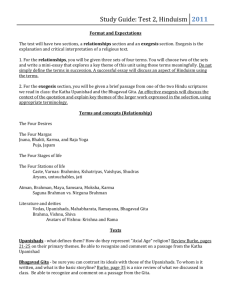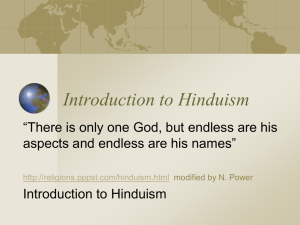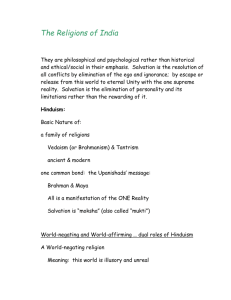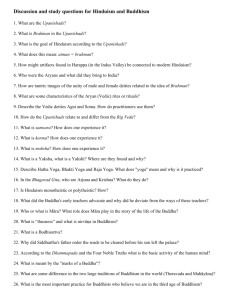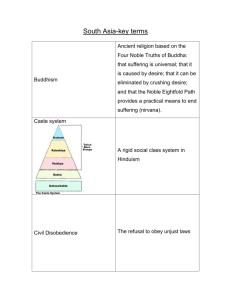Concept of Salvation in Hinduism by Tahira Basharat
advertisement
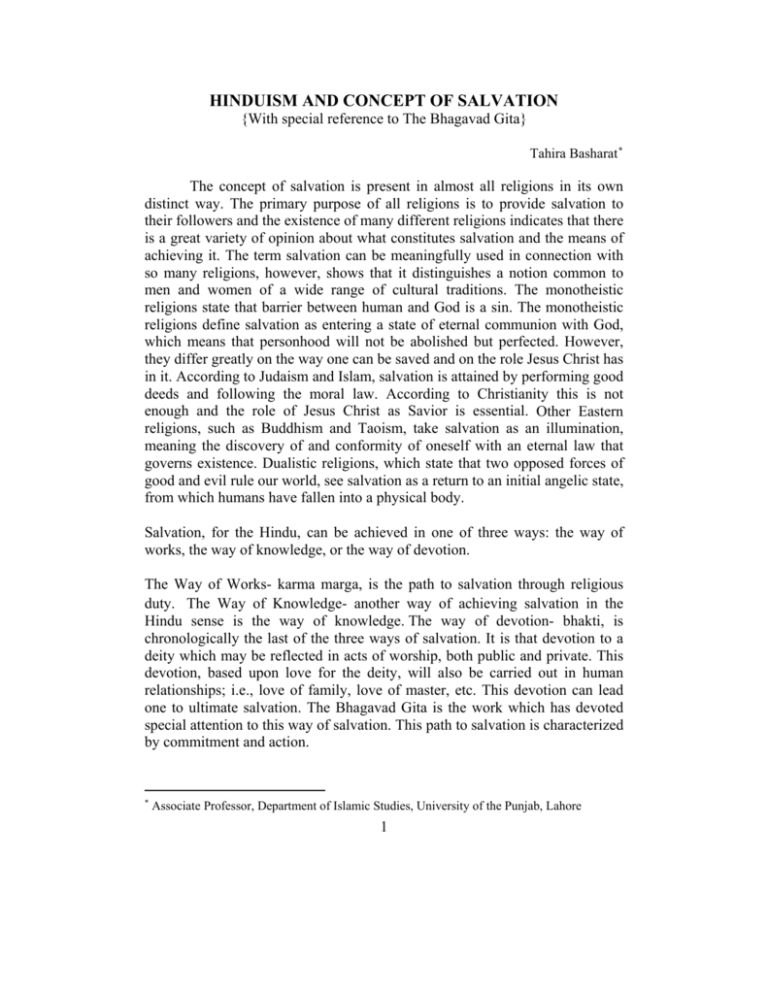
HINDUISM AND CONCEPT OF SALVATION
{With special reference to The Bhagavad Gita}
Tahira Basharat ∗
The concept of salvation is present in almost all religions in its own
distinct way. The primary purpose of all religions is to provide salvation to
their followers and the existence of many different religions indicates that there
is a great variety of opinion about what constitutes salvation and the means of
achieving it. The term salvation can be meaningfully used in connection with
so many religions, however, shows that it distinguishes a notion common to
men and women of a wide range of cultural traditions. The monotheistic
religions state that barrier between human and God is a sin. The monotheistic
religions define salvation as entering a state of eternal communion with God,
which means that personhood will not be abolished but perfected. However,
they differ greatly on the way one can be saved and on the role Jesus Christ has
in it. According to Judaism and Islam, salvation is attained by performing good
deeds and following the moral law. According to Christianity this is not
enough and the role of Jesus Christ as Savior is essential. Other Eastern
religions, such as Buddhism and Taoism, take salvation as an illumination,
meaning the discovery of and conformity of oneself with an eternal law that
governs existence. Dualistic religions, which state that two opposed forces of
good and evil rule our world, see salvation as a return to an initial angelic state,
from which humans have fallen into a physical body.
Salvation, for the Hindu, can be achieved in one of three ways: the way of
works, the way of knowledge, or the way of devotion.
The Way of Works- karma marga, is the path to salvation through religious
duty. The Way of Knowledge- another way of achieving salvation in the
Hindu sense is the way of knowledge. The way of devotion- bhakti, is
chronologically the last of the three ways of salvation. It is that devotion to a
deity which may be reflected in acts of worship, both public and private. This
devotion, based upon love for the deity, will also be carried out in human
relationships; i.e., love of family, love of master, etc. This devotion can lead
one to ultimate salvation. The Bhagavad Gita is the work which has devoted
special attention to this way of salvation. This path to salvation is characterized
by commitment and action.
∗
Associate Professor, Department of Islamic Studies, University of the Punjab, Lahore
1
In order to comprehend and explain the concept of salvation in the
religion of Hinduism, it is imperative to know about it.
Hinduism is the oldest of all the living religions. It has neither any
definite date of its origin nor has it any definite founder associated with it. It is
called Santana dharma, a religion coming down to people through eternity. It is
thus a unique religion in one very important sense. Nearly every religion of the
world is associated with a definite personality claimed to be its first originator
or founder and has a definite text which is regarded as its basic religious text.
But Hinduism has none. It can more be regarded as spontaneous growth
assisted at various stages of civilization from various sides rather than a
creation or construction of somebody.
Various renowned commentators and authors have expressed their views about
the religion of Hinduism in such words.
Sir Charles Eliot remarks in this connection, “Hinduism has not been made,
but has grown. It is a jungle, not a building.” (1) Similarly, K. M. Sen makes
the following observations in his book Hinduism, “Hinduism is more like a
tree that has grown gradually than like a building that has been erected by
some great architect at some definite point in time. It contains within itself the
influences of many cultures and the body of Hindu thought thus offers as much
variety as the Indian nation itself.” (2)
It can be extracted that this religion is not actually stemming from a single root
rather it shares various roots situated around.
John. B. Noss describes the full details in his different books concerning the
Hinduism. In one of his books he writes, “Hinduism has no one as its definite
founder and no book as its one exclusive text but also that it has got no welldefined, rigid and dogmatic principles of faith or practice. Varying beliefs and
practices can be found amongst those who call themselves Hindus.
A polytheist is as much a Hindu, as a monotheist or a monist or even an
atheist. Hinduism is really a vast and apparently incoherent religious complex.
It is rightly characterized as a vast jungle in which it is very difficult to mark
out how many kinds of trees and plants flourish. In fact, to summaries the main
principles, beliefs and practices of any religion is very difficult, but in case of
Hinduism it seems impossible. The variety and complexity of Hindu beliefs
and practices can be seen implied into the very basic philosophy (of religions)
that Hinduism entertains and professes.
2
There is only one basic reality underlying everything which is differently
named in different religions. All the different religions are really like different
paths leading to the same goal. So there is no question that it is not one
religion, but rather a family of religions. Hinduism is fluid and changing.
Hinduism is the whole complex of beliefs and institutions that have appeared
from the time when their ancient (and most sacred) scriptures, the Vedas, were
composed until now. Hindus have an extraordinarily wide selection of beliefs
and practices to choose from: they can (to use Western terms) be pantheists,
polytheists, monotheistic, agnostics or any rigid set of principles or practices.
Everyone has got the right to follow his own path and to approach God in his
own way. Hinduism never claims that a particular prophet is the prophet and a
particular faith is the faith. Id ode sot believe in inflicting rigid rules of prayer,
worship etc. As a matter of fact, the way of worship or prayer or any other
such way is not the only way of realizing God or attaining salvation. The way
of knowledge (Janana marga), the way of action (Karma marga) and the way
of worship and prayer (Bhakti marga). Anyone according to temperament may
adopt any of these ways and can attain the salvation. Thus Hinduism is in its
very temperament against any rigid rules of religion. It is very liberal and
broad hearted in its approach and outlook.”(3) Thomas Patrick Burke has same
views, “Hinduism is not a unified and single entire, but the sum total of the
traditional religious beliefs and practices of the Indian people, a colorful,
diverse, and complex set of traditions inherited from a long history, and
sometimes only loosely.” (4)
The above statements of the author show that Hinduism is such a complex
and oldest religion which has different beliefs and practices. It has not one
founder, one scripture moreover it consists of many sects and different paths of
salvation.
Joseph Gaer also describes the complexities of Hinduism in the same way,
“Just as the attributes of Hindu Triad multiplied until there were millions of
them and the cast divided and subdivided from the original four to a very large
number. It is an extremely old religion and has given rise to many sects.” (5)
To summarize the thought of any religion is difficult, but in the case of
Hinduism it is impossible. It is the essence of Hinduism that there are many
different ways of looking at a single object, none of which will give the whole
view, but each of which is entirely valid in its own right. As John Bowker
observes about Hinduism, “A statue may be viewed from many angles. Each
aspect helps to convey what the statue is like, but no single aspect is able to
3
comprehend the statue as a whole, still less does the act of viewing it from one
particular angle or another constitute "the statue itself”(6)
What is salvation in Hinduism?
In Hinduism, salvation is the Atmans’ (individual’s soul), liberation
from Samsara, the cycle of death and rebirth and attainment of the highest
spiritual state. It is the ultimate goal of Hinduism, where even hell and heaven
are temporary. This is called moksha (Sanskrit: "liberation") or mukti
(Sanskrit: "release"). Moksha is a final release from one's worldly conception
of self.”(7)
Salvation can be termed as one of the most essential part of a belief system and
religious rituals of a Hindu.
Monier-Williams describes the characteristics of Brahman as, “Brahman is the
universal substrate and divine ground of all being. Moksha is achieved when
the individual Atman unites with the ground of all being - the source of all
phenomenal existence — Brahman through practice of Yoga. Hinduism
recognizes several paths to achieve this goal, none of which is exclusive. The
paths are the way of selfless work (Karma Yoga), of self-dissolving love
(Bhakti Yoga), of absolute discernment & knowledge (Jnana Yoga)” (8)
The Upanishads have also taken up the task of emphasizing the
importance of Brahman and its significance in the central theology of
Hinduism. The Upanishads, the most important of the commentaries, were put
in writing around 500 B.C.E. It is reaffirmed in the Upanishads that Hinduism
is centered upon the belief that all things in the universe are connected and are
a part of the single existing thing, called Brahman. Unlike in the western
religions, this central being is not a personal god in which humans pray to and
have a relationship with. Instead, humans are an expression of Brahman as are
all other creatures and objects in the universe. The Atman obtains a human
body at birth and uses it through its lifetime to serve a purpose within the
Dharma and to try to free itself from Samsara. Concept of Brahman is
illustrated in this famous passage from the Upanishad:
"Place this salt in water and come to me tomorrow morning."
Svetaketu did as he was commanded, and in the morning his father said to
him: "Bring me the salt you put into the water last night."
Svetaketu looked into the water, but could not find it, for it had dissolved.
His father then said: "Taste the water from this side. How is it?"
"It is salt' "
4
"Taste it from the middle. How is it?" "It is salt."
"Taste it from that side. How is it?" "It is salt."
"Look for the salt again, and come again to me."
The son did so, saying: "I cannot see the salt. I only see water."
His father then said: "In the same way, O my son! you cannot see the
spirit. But in truth it is there. An invisible and subtle essence is the Spirit
of the whole universe. That is Reality. That is Truth.” (9) Taittiriya
Upanishad states, “He who knows the Bliss of Brahman (divine
consciousness) does not distress himself with the thought "why did I not
do what is good? Why did I do what is evil?" Whoever knows this (bliss)
regards both of these as Atman (self, soul), indeed he cherishes both as
Atman. Such, indeed, is the Upanishad, the secret knowledge of
Brahman.” (10)
The key phrase of the Upanishads, believe that in the end, the ultimate,
formless, inconceivable Brahman is the same as our soul, Atman. We only
have to realize this through discrimination.
After analyzing the references above, the notion of salvation could be
easily summarized that Salvation in Hinduism is called Moksha and Moksha is
attained when an enlightened human being is freed from the endless cycle of
death and reincarnation and comes into a state of completeness; completeness
of being one with Brahman.
This is also illustrated by the Bhagavad-Gita, a Hindu text, when
Arjuna asks Lord Krishna to show him his true form and Krishna responds:
“Arjuna, see all the universe, animate and inanimate, and whatever else
you wish to see; all stands here as one in my body. Lord Krishna said: O
Arjuna, listen once again to my supreme word that I shall speak to you,
who is very dear to Me, for your welfare. Neither the celestial controllers,
nor the great sages know My origin, because I am the origin of celestial
controllers and great sages also. One who knows Me as the unborn, the
beginning less, and the Supreme Lord of the universe, is considered wise
among the mortals, and becomes liberated from the bondage of
Karma.”(11)
Lord Krishna goes on to explain his supreme being in the chapter 10, “Lord
Krishna said: O Arjuna, now I shall explain to you my prominent divine
manifestations, because My manifestations are endless. O Arjuna, I am the
Supreme Spirit (or Super soul) abiding in the inner psyche of all beings. I am
also the creator, maintainer, and destroyer ⎯ or the beginning, the middle, and
5
the end ⎯ of all beings. I am the sustainer, I am the radiant sun among the
luminaries, I am the controller of wind, I am the moon among the stars. I am
the Vedas, I am the celestial rulers, I am the mind among the senses, I am the
consciousness in living beings. I am Lord Shiva, I am the god of wealth, I am
the fire god, and the mountains. I am the priest, and the army general of the
celestial controllers, O Arjuna. I am the ocean among the bodies of water. I am
the monosyllable cosmic sound, OM, among the words; I am the chanting of
mantra among the spiritual disciplines; and I am the Himalaya among the
mountains.” (12) When Arjuna witnesses Krishna’s true form as Brahman, he
says, “My illusion is dispelled by the profound words of wisdom You spoke
out of compassion towards me about the supreme secret of Spirit. I see your
boundless form everywhere, the countless arms, bellies, mouths, and eyes;
Lord of All, I see no end, or middle or beginning to your totality. O Krishna, I
have heard from you in detail about the origin and dissolution of beings, and
your immutable glory.”(13)
When Arjuna sees Lord Krishna he sees the entire universe because
everything in the universe is part of Brahman therefore Lord Krishna is
everything. During one’s lifetime it is believed that they are just one piece of
Brahman called the Atman which is immortal and experiences many lifetimes.
Lord Krishna describes the Atman in The Bhagavad-Gita, “O Arjuna, how
can a person who knows that the Spirit is indestructible, eternal, unborn, and
immutable, kill anyone or causes anyone to be killed?” (14)
Min, Anselm Kyongsuk explains the characteristics of Brahman in these
words, “Brahman is defined as an eternal, genderless, infinite Being, who is
the Absolute reality. The role of Brahman is important in understanding
Moksha because the paths leading to the liberation of Samsara occur when the
Atman realizes it’s a source of this Super Soul called Brahman. In Hinduism,
this realization and Moksha can be done through various paths (Yogas). And
different Hindu philosophical schools put emphasis on different paths. One
path in particular is that of Bhakti Yoga, or complete loving devotion to
God”.(15)
This form of Yoga can be found in the message of Krishna in the The
Bhagavad Gita, where he tells to Arjuna,
“Keep me in your mind and devotion, sacrifice to me, bow to me, discipline
yourself toward me and you will reach me!” (16)
6
As it is evident from above discussion, to achieve salvation or Moksha, is
the realization of the existence of the super being Brahman. One path in
particular, to attain that realization, is that of Bhakti Yoga, or complete loving
devotion to God.
We find this form of Yoga in the message of Krishna in the The Bhagavad
Gita, where he tells Arjuna: “Always think of Me, be devoted to Me, worship
Me, and bow down to Me. Thus uniting yourself with Me by setting Me as the
supreme goal and the sole refuge, you shall certainly come to Me.” (17)
This is illustrated by the Bhagavad-Gita that when Arjuna asks Lord Krishna to
show him his true form and Krishna responds, “Arjuna, see all the universe,
animate and inanimate, and whatever else you wish to see; all stands here as
one in my body”. When Arjuna witnesses Krishna’s true form as Brahman he
says, “All the celestial beings amazingly gaze at You. Seeing your infinite
form with many mouths, eyes, arms, thighs, feet, stomachs, and many fearful
tusks; the worlds are trembling with fear and so do I, O mighty Lord.” (18)
When Arjuna sees Lord Krishna he sees the entire universe because everything
in the universe is part of Brahman therefore Lord Krishna is everything.
During one’s lifetime it is believed that they are just one piece of Brahman
called the Atman which is immortal and experiences many lifetimes. Lord
Krishna describes the Atman in The Bhagavad-Gita, “The invisible Spirit is
eternal, and the visible physical body, is transitory. The reality of these two is
indeed certainly seen by the seers of truth.” (19)
Now we come to three paths of Salvation. The three paths he teaches are
selfless action (Karma Yoga), self-transcending knowledge (Jannaa Yoga), and
devotion (Bhakti Yoga). The first path is that of action (Karma Yoga). Krishna
advises Arjanna about the first path as:
“Do your duty to the best of your ability, O Arjuna, with your mind
attached to the Lord, abandoning worry and selfish attachment to the
results, and remaining calm in both success and failure. The selfless
service is a yogic practice that brings peace and equanimity of mind. You
have control over doing your respective duty only, but no control or claim
over the results. The fruits of work should not be your motive, and you
should never be inactive. A man of inner strength whose senses experience
objects without attraction and hatred, in self control You have control
over doing your respective duty only, but no control or claim over the
results. The fruits of work should not be your motive, and you should
never be inactive.” (20)
7
If we study above quotations we come to know that Krishna gives
importance to selfless service and if a work is done by selfishness it comes in
inferiority as compared to selfless service. He further tells that if one struggles
for something it never goes waste, struggle always brings positive effects and
there is no question of adversity. He further goes on; a little selfless practice
keeps the person away from the fear of repeated birth and death.
A selfless person has great determination of God-realization where he
works to enjoy the best fruits of struggle which are endless.
Krishna further advices that a person who puts aside the fruits of his works
voluntarily, lives a happy life in the city of Nine Gates, neither performing nor
directing action.
Karma-yogi is always free from the bounds of rebirth because he keeps the
selfishness aside which results in pleasing divine state of salvation or Nirvana.
He says that when your wisdom completely breaks the veil of perplexity then a
person becomes careless about what he has heard from here and there or from
the scriptures.
Arjana asks about the enlightened person in this way:
“Arjuna said: O Krishna, what are the marks of an enlightened person
whose intellect is steady? What does a person of steady intellect think and
talk about? How does such a person behave with others, and live in this
world?” (21) Krishna answers his questions as “When one is completely
free from all desires of the mind and is satisfied with the Supreme Being
by the joy of Supreme Being, then one is called an enlightened person, O
Arjuna. A person whose mind is unperturbed by sorrow, who does not
crave pleasures, and who is completely free from attachment, fear, and
anger, is called an enlightened sage of steady intellect.”(22)
After discussing the firs path of Salvation, we see what does
Krishna tells about the second Path which is the path of Knowledge (Janna
yoga)
He tells him that when a person destroys his ignorance by the path of
knowledge, it illumines ultimate reality. Then he explains the ultimate reality
according to which Brahman is everywhere even in inside of a person. Krishna
further says about the path of knowledge that it leads someone to have
salvation by realizing Brahman.
8
Here Krishna further teaches about Janna yoga that is path of knowledge as:
“This knowledge comes in the form of being able to discern what is truth,
what is eternal, and what is not. This leads a person to realize the one True
Self (Brahman) is everywhere, and realizing this is true knowledge. Work
does not bind a person who has renounced work ⎯ by renouncing the
fruits of work ⎯ through Karma-yoga, and whose confusion with regard
to body and Spirit is completely destroyed by the application of Selfknowledge, O Arjuna.” (23)
In the light of above quotation, knowledge of the transcendent and
Krishna, a person can find refugee in the supreme lord with true devotion and
attains complete peace and eternal destination.
Krishna further goes on:
“The Lord does not take the responsibility for the good or evil deeds of
anybody. The veil of ignorance covers the Self-knowledge; thereby people
become deluded and do evil deeds.” (24)
After having the discussion about the path of knowledge we lead to third path
of salvation which is known as Bhagti yoga. It shows complete loving
devotion to Krishna. He explains that salvation and moksha both are attained
having complete devotion to him.
Karishna emphasis on the importance of this path and advises:
“My devotee attains peace by knowing the Supreme Being as the enjoyer
of sacrifices and austerities, as the great Lord of the entire universe, and as
the friend of all beings.” (25) “Always think of Me, be devoted to Me,
worship Me, and bow down to Me. Thus uniting yourself with Me by
setting Me as the supreme goal and the sole refuge, you shall certainly
come to Me.” (26)
He further goes on: “Set aside all meritorious deeds and religious rituals, and
just surrender completely to My will with firm faith and loving devotion. I
shall liberate you from all sins, the bonds of Karma. Do not grieve.” (27) After
listening to all advices, Arjuna Said: “By Your grace my delusion is
destroyed, I have gained Self-knowledge, my confusion with regard to body
and Spirit is dispelled and I shall obey your command.” (28)
Salvation, and oneness with Krishna, can be attained merely by Transcendental
knowledge and devoting yourself completely to Him. It is apparent from the
saying of Krishna given below: “Transcendental knowledge destroys the
9
ignorance of the Spirit and reveals the Supreme Being just as the sun reveals
the beauty of objects of the world.” (29)
CONCLUSION
Hinduism is a complex religion with long and interesting history. It has
developed so much from the time of the Indus and Aryan people to the present
day. It has become an integral part of a complex culture in India and other
countries. In Hinduism, the central idea of Brahman, Dharma, Karma and
Moksha in some form was carried over to other major religions such as
Buddhism and Jainism and as life philosophies for many others. Discussion
shows that it is one of the most influential religions in the world and its one of
the basic philosophy of salvation could be knowledge gaining for an avid
reader. It centres upon the belief that all things in the universe are connected
and are part of the one simple existing thing called Brahman. In this religion
the ultimate objective of Salvation is flight from the eternal round of birth,
death and rebirth and dissolving of all personality into the incredible gulf of
Brahman. Discussion concludes that majority of Hindus believe that they have
many incarnations before they can stumble on final salvation, although some
sects consider that a cardinal divinity will carry them along the way more
speedily. The three paths of salvation which have been discussed in the article
are very important in this religion to get the real goal of the life of every
person. The most difficult part in the life of a human being is to be on the right
path to attain Moksha because one has to control over five senses.
Since God is what is the most real, the Hindu tends to see all the varied
manifestations of the world as essentially one, as merely different aspects of
the same fundamental reality. What we call Hinduism today is not a unified
and a single entity, but the sum total of religious beliefs and practices of Indian
people, a colorful, diverse, and a complex set of traditions inherited from a
long history, and sometimes only loosely related to one another. Each period of
Indian history has left its mark and is embodied in its own distinctive writings.
This diversity allows individuals good deal of liberty in choosing a form of
religious life suitable to their needs.
If there is one theme that runs through these different traditions,
summing up perhaps what is most typical of Hinduism as whole, is a feeling of
the inherent presence of the divine in every being. And the concept of salvation
is a common point between Hinduism and other religions although there is a
difference of theme and ideology but nonetheless it provides a common
ground.
10
REFERENCES
1.
2.
3.
4.
5.
6.
7.
8.
9.
10.
11.
12.
13.
14.
15.
16.
17.
18.
19.
20.
21.
22.
Eliot, Charles, Hinduism and Buddhism. 2008 Tokyo. Vol I P48
Sen, K. M. Hindusim, Penguin Books. 2005. P-14-15
Noss, John B. Man’s Religion, New York. 1969 PP 88-90
Burke, Thomas Patric, The Major Religions: An Introduction with Texts.
Maldon, MA 1996. P-16
Gaer, Joseph The complexities of Hinduism: What the great religions
believe. Dodd, Mead and Co. New York, 1963. P-36.
Bowker, John The Problems of Suffering in the religions of the world.
Cambridge University Press. London. 1970. P-193
http://www.comparativereligion.com/salvation.html#15
Salvation." Macmillan Dictionary of the Bible. London: Collins, 2002
Chandogya Upanishads – Chapter 16
Taittiriya Upanishad, chapter 9
Arnold, Edwin. English translation of The Bhagavad Gita; Chapter 10.
Verse -1-3
Miller, Barbara Stoller English Translation of The Bhagavad Gita
Chapter11 Verse 21-2
Miller, Barbara Stoller English Transaltion of The Bhagavad Gita
Chapter 9 Verse 34
Miller, Barbara Stoller English Transaltion of The Bhagavad Gita
Chapter 11 Verse
Min, Anselm Kyongsuk. Dialectic of Salvation: Issues in Theology of
Liberation. Albany, N.Y.: State University of New York Press, 19892122
Arnold, Edwin. English translation of The Bhagavad Gita Chapter 2
Verse 16
Miller, Barbara Stoller English Transaltion of The Bhagavad Gita
Chapter 2 Verse 18-20
Miller, Barbara Stoller English Transaltion of The Bhagavad Gita
Chapter 9 Verse 34
Arnold, Edwin. English translation of The Bhagavad Gita Chapter 2
Verse 47-48
Arnold, Edwin. English translation of The Bhagavad Gita Chapter 2
Verse 41-45.
Arnold, Edwin. English translation of The Bhagavad Gita Chapter 2
Verse 50
Arnold, Edwin. English translation of The Bhagavad Gita Chapter 2
Verse 55-56
11
23.
24.
25.
26.
27.
28.
29.
Arnold, Edwin.
Verse 41
Arnold, Edwin.
Verse 15
Arnold, Edwin.
Verse 29
Arnold, Edwin.
Verse 34
Arnold, Edwin.
Verse 66
Arnold, Edwin.
Verse 73
Arnold, Edwin.
Verse 16
English translation of The Bhagavad Gita Chapter 4
English translation of The Bhagavad Gita Chapter 5
English translation of The Bhagavad Gita Chapter 5
English translation of The Bhagavad Gita Chapter 9
English translation of The Bhagavad Gita Chapter 18
English translation of The Bhagavad Gita Chapter 18
English translation of The Bhagavad Gita Chapter 5
12
